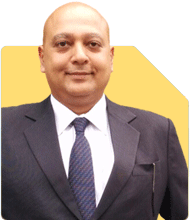Is Early Retirement at 50 Possible with a 1 Crore Investment Portfolio?
Ramalingam Kalirajan |9755 Answers |Ask -Follow
Mutual Funds, Financial Planning Expert - Answered on Sep 19, 2024
He has an MBA in finance from the University of Madras and is a certified financial planner.
He is the director and chief financial planner at Holistic Investment, a Chennai-based firm that offers financial planning and wealth management advice.... more

Namaskar. Sir I am 36 year old having two daughters 9years and 5 years old, i have near about 1 cr as gold, 3 lac in share market, 5 lac in mutual funds and 3 lac in EPF. working in private company salary is 50000 rs per month. now my question is that i want early retirement in age of 50 and want to do a world tour, how i can plan all this. I have no need of any loan in future also. thanks in advance
Rs 1 crore in gold
Rs 3 lakhs in the share market
Rs 5 lakhs in mutual funds
Rs 3 lakhs in EPF
You also have a monthly salary of Rs 50,000 from your private job and no loans to worry about. Having a financial goal is the first step, but the challenge is ensuring that your investments grow steadily to meet your retirement and lifestyle aspirations.
Let’s look at a comprehensive approach to achieve this.
Define Your Financial Goals
You mentioned two key goals:
Early Retirement at 50: This means you have around 14 years to build your corpus. After retirement, you need to ensure that you generate enough income to cover your living expenses.
World Tour: This is a great ambition, but it requires careful planning. World travel costs can vary greatly, so having an estimate in mind will be important.
Now, considering your current savings and earnings, you will need a larger corpus for both retirement and travel. This means that your savings and investments must grow faster than inflation and be sufficient for both goals.
Building a Retirement Corpus
To retire at 50 and sustain your lifestyle, you’ll need a corpus that can generate enough passive income. Here’s how you can plan:
Invest More Aggressively: Currently, you have Rs 3 lakhs in the share market and Rs 5 lakhs in mutual funds. With your goal of early retirement, it would be beneficial to increase your investment in equity mutual funds. Equity has the potential to provide higher long-term returns compared to traditional options.
EPF Contributions: You have Rs 3 lakhs in EPF, which is a good base for retirement. EPF offers stable returns, but it may not grow fast enough to match your early retirement plan. Consider increasing contributions if possible, but don’t rely solely on it for long-term growth.
Gold Holdings: You have Rs 1 crore in gold, which is substantial. While gold is a good asset, it doesn’t generate income and can be volatile. You might want to consider reducing your gold holding over time and reallocating that into more income-generating investments, such as mutual funds or fixed-income instruments. This can provide you with both growth and security.
Increase SIP Investments: Start or increase your systematic investment plan (SIP) in equity mutual funds. SIPs in equity funds over a long period can help in building wealth. Actively managed funds, as opposed to index funds, can provide better growth with professional fund managers making the decisions.
Managing Risks in Investment
You have expressed concerns about market-linked investments like stocks and mutual funds. These concerns are valid, but they can be managed with proper diversification and long-term focus.
Stock Market: While you only have Rs 3 lakhs in the stock market, consider increasing this exposure but with diversification. A well-diversified portfolio can reduce risk while allowing for potential growth. Avoiding high-risk, speculative stocks is key; focus on blue-chip stocks or large-cap companies with strong fundamentals.
Mutual Funds: Investing through mutual funds rather than directly in stocks can also help. Opting for regular mutual funds with the help of a certified financial planner (CFP) ensures that an expert manages your money. Active fund management allows the flexibility to adapt to market changes and potentially achieve better returns.
Tax-Efficient Investment Strategies
One of the key aspects of planning for retirement and travel is minimising tax liability. Here are some strategies you could consider:
Equity-Linked Savings Scheme (ELSS): ELSS investments are tax-saving mutual funds that can help you save on taxes while growing your wealth. The returns from these funds are subject to long-term capital gains (LTCG) tax, which is generally lower than other forms of taxation.
Tax-Efficient Mutual Funds: You can also consider investing in other tax-efficient funds, which allow you to grow your money while reducing the tax burden.
Maximising EPF and PPF: Since you already contribute to EPF, consider starting a Public Provident Fund (PPF) if you haven’t yet. PPF offers tax-free returns and is a long-term savings option, ideal for retirement planning.
Health and Life Insurance: Ensure that you have adequate health and life insurance. These will protect you and your family and offer tax benefits under sections 80C and 80D of the Income Tax Act. The premium paid for health insurance and life insurance qualifies for tax deductions.
Allocating Funds for Your World Tour
While planning for retirement, you’ll also need to set aside a specific fund for your world tour. Here's how you can do this:
Goal-Based Investment: Set a target amount you need for your world tour. For instance, if you plan to take this trip right after your retirement at 50, you’ll need to ensure this amount is separate from your retirement corpus.
Dedicated SIP for Travel: You can create a separate SIP in a balanced mutual fund, which offers stability and growth, to save for this goal. This will allow your travel fund to grow without affecting your retirement savings.
Short-Term Fixed Income Instruments: If you’re looking for a relatively safer option, consider investing in short-term debt funds or fixed-income instruments closer to the time of your world tour. These can provide liquidity and safety for your travel fund.
Estate Planning and Children's Future
With two daughters, planning for their future education and possibly marriage expenses is essential. Here’s how you can ensure this:
Sukanya Samriddhi Yojana (SSY): If you haven’t yet, you could consider investing in SSY for your daughters. This is a government-backed scheme that offers attractive returns and tax benefits. It’s specifically designed to cater to the education and marriage needs of girls.
Children’s Education Fund: You should also start a dedicated education fund for your daughters. Education costs, especially for higher education, are rising, and planning for it early will give you peace of mind.
Nomination and Will: Ensure that you have a proper will in place. This is crucial for ensuring that your wealth is passed on to your loved ones without legal hassles. Include all your major assets such as gold, mutual funds, shares, and other investments in your will.
Managing Gold Holdings Effectively
You hold Rs 1 crore in gold, which is a significant amount. While gold is a hedge against inflation, it doesn’t generate income. Here’s how you can better utilise this asset:
Sovereign Gold Bonds (SGB): Instead of holding physical gold, consider converting some of your gold holdings into SGBs. SGBs provide an interest income along with price appreciation. This way, you’ll continue to benefit from the rise in gold prices while earning a passive income.
Reduce Physical Gold: Consider liquidating a portion of your physical gold to reinvest in higher-yielding assets. The money from this can be used to further invest in equity or mutual funds, thus boosting your retirement corpus.
Contingency Fund and Emergency Planning
While planning for retirement and travel, it’s also important to have an emergency fund. This fund should cover at least 6-12 months of your expenses in case of unforeseen circumstances like job loss or medical emergencies.
Emergency Fund: Since you already have some liquid assets, ensure you keep a portion of your Rs 50,000 salary aside every month for this purpose. Ideally, this should be kept in a liquid fund or savings account for quick access.
Health Insurance: Ensure you have a comprehensive health insurance plan to avoid dipping into your retirement savings during medical emergencies.
Finally
Your financial foundation is strong with gold, mutual funds, shares, and EPF contributions. To retire at 50 and fund a world tour, you need to boost your investments with more strategic and tax-efficient approaches. Focus on building a larger retirement corpus through mutual funds and SIPs. Use your gold more effectively by converting part of it into income-generating assets. Don't forget to plan for your children’s education and secure your family's financial future through proper estate planning.
A well-balanced investment plan, along with disciplined savings, will help you retire early and achieve your dreams.
Best Regards,
K. Ramalingam, MBA, CFP,
Chief Financial Planner,
www.holisticinvestment.in
You may like to see similar questions and answers below
Ramalingam Kalirajan |9755 Answers |Ask -Follow
Mutual Funds, Financial Planning Expert - Answered on Jul 17, 2024
Ramalingam Kalirajan |9755 Answers |Ask -Follow
Mutual Funds, Financial Planning Expert - Answered on Jul 12, 2024
Ramalingam Kalirajan |9755 Answers |Ask -Follow
Mutual Funds, Financial Planning Expert - Answered on Jan 03, 2025
Milind Vadjikar | Answer |Ask -Follow
Insurance, Stocks, MF, PF Expert - Answered on Jan 21, 2025
Milind Vadjikar | Answer |Ask -Follow
Insurance, Stocks, MF, PF Expert - Answered on Jan 26, 2025
Sushil Sukhwani |614 Answers |Ask -Follow
Study Abroad Expert - Answered on Jul 16, 2025
Archana Deshpande |116 Answers |Ask -Follow
Image Coach, Soft Skills Trainer - Answered on Jul 16, 2025
Nayagam P P |8910 Answers |Ask -Follow
Career Counsellor - Answered on Jul 16, 2025
Nayagam P P |8910 Answers |Ask -Follow
Career Counsellor - Answered on Jul 16, 2025
Archana Deshpande |116 Answers |Ask -Follow
Image Coach, Soft Skills Trainer - Answered on Jul 16, 2025
Nayagam P P |8910 Answers |Ask -Follow
Career Counsellor - Answered on Jul 16, 2025
Dr Nagarajan J S K |1810 Answers |Ask -Follow
NEET, Medical, Pharmacy Careers - Answered on Jul 16, 2025
Dr Nagarajan J S K |1810 Answers |Ask -Follow
NEET, Medical, Pharmacy Careers - Answered on Jul 16, 2025
Dr Nagarajan J S K |1810 Answers |Ask -Follow
NEET, Medical, Pharmacy Careers - Answered on Jul 16, 2025
Nayagam P P |8910 Answers |Ask -Follow
Career Counsellor - Answered on Jul 16, 2025










.jpg)














